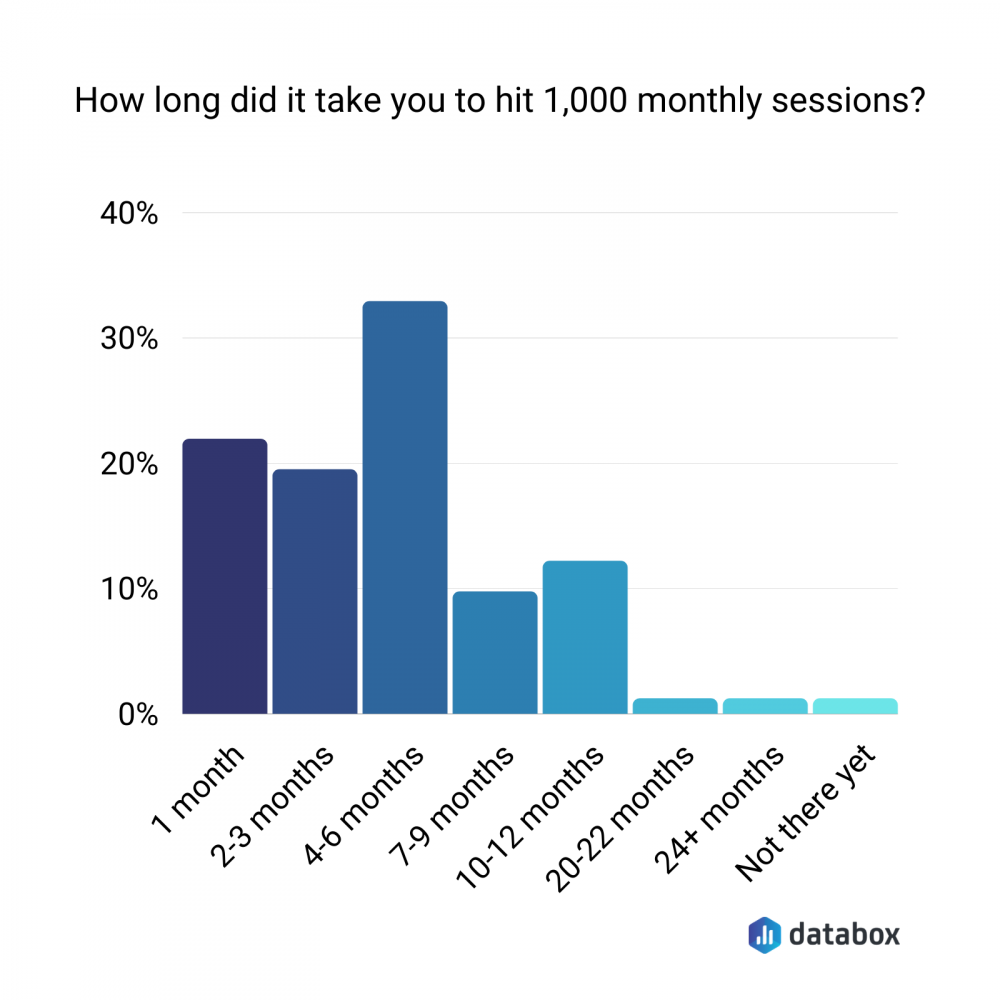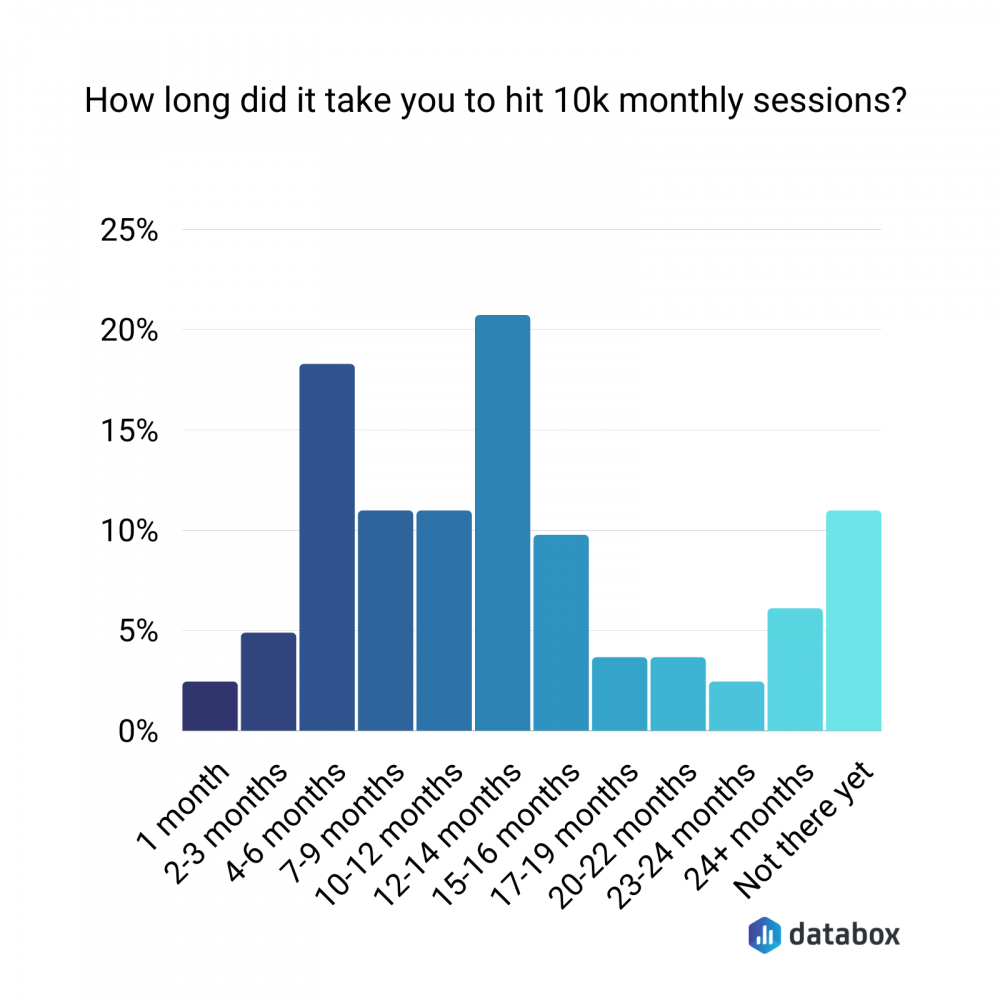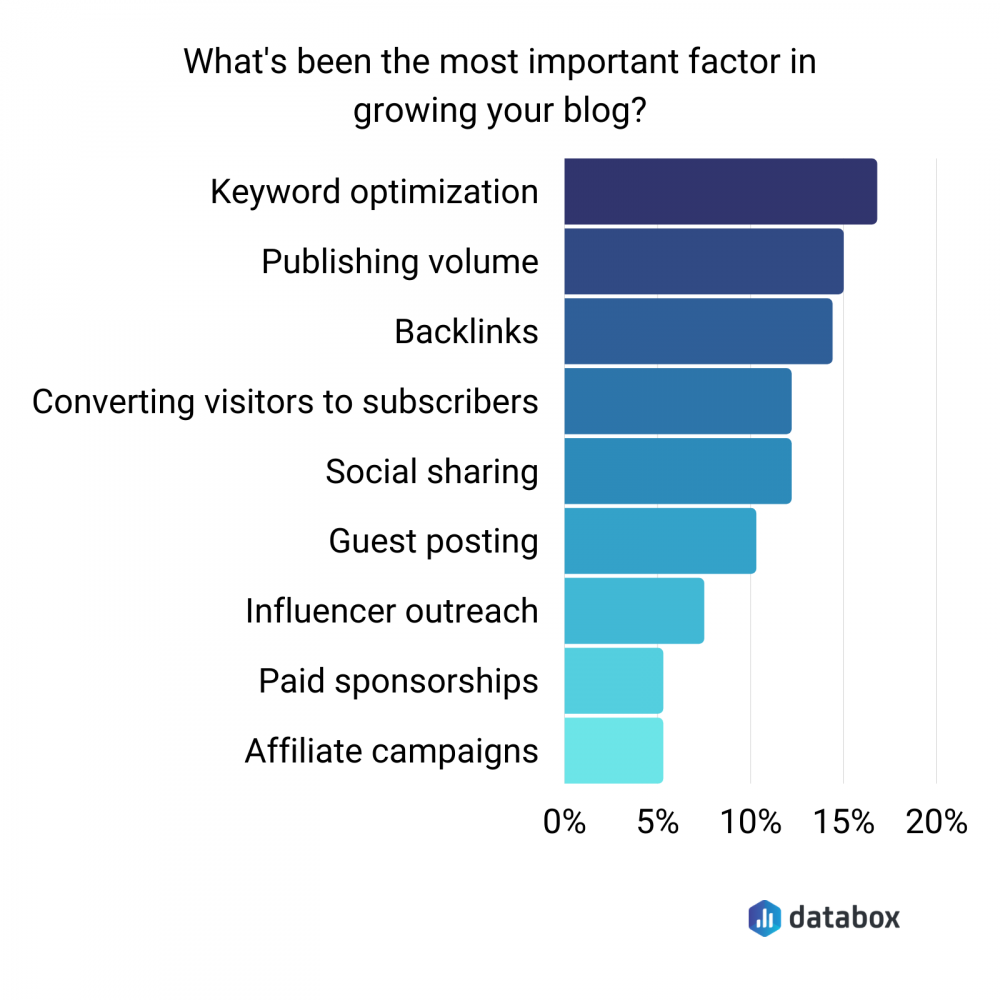Table of contents
After getting your blog off the ground, here comes the next and even bigger challenge, and that’s learning how to grow a blog.
Although there is no hack or a shortcut to growing a blog (it really takes a lot of time and effort) there are a lot of things you can do to push it in the right direction and simply help it grow faster.
Don’t know where to start? Here is a checklist that contains 23 expert tips sourced from over 30+ internet marketing and blogging experts.
- Find your blog’s unique value proposition
- Work on building your blog’s authority
- Pick between building an audience or getting more eyeballs
- Be clear about who your audience is
- Become an active part of your niche community
- Take out time for keyword research
- Target informational keywords
- Focus on on-page SEO
- Focus on producing content
- Pay attention to the value you offer
- Create a publishing schedule
- Invest in quality writers
- Create a distribution strategy
- Use social media to grow your blog
- Repurpose content to keep your content pipeline full
- Identify what’s working for your competitors
- Use video to grow your blog
- Build quality links
- Focus on expertise and authority
- Create pillar-cluster models
- Work on your blog’s user experience
- Be consistent
- Update your blog posts
Let’s cut to the chase.
1. Find your blog’s unique value proposition
When it comes to growing your blog, Alex Birkett from Omniscient Digital suggests you “Start from step zero: ask yourself, ‘why me?’ or ‘what unique value am I providing with this blog?’”
Birkett elaborates, “It could be the case that, in your industry, there are few or no good blogs. So simply organizing knowledge in a curated way is valuable on its own.
More likely, your space is crowded with some or many blogs, and you need to figure out why people should read yours as opposed to all the others. Simply rehashing content won’t generally do it.
When I worked at CXL, we differentiated through long-form, research-backed content. We didn’t shy away from advanced topics or technical discussions. This, at the time, was unique in the marketing space, and people loved that style (I still type in site:cxl.com ‘topic’ when I want to learn something specific).
It’s all about finding your unique value proposition and executing on that.”
PRO TIP: Measure Your Content Marketing Performance Like a Pro
Struggling to track the impact of your content across platforms? We feel you. Thanks to Databox, fragmented data doesn’t have to hold you back anymore.
Our library of free content marketing dashboard templates puts all the insights and metrics you need in one place. No more jumping between reports!
Measure engagement: Track key metrics like likes, comments, shares across social media platforms to see what content resonates most with your audience. Analyze website traffic, bounce rate, and average time on page to understand how visitors interact with your content.
Optimize conversions: Identify high-performing landing pages and blog posts that drive the most leads using dashboards like HubSpot Marketing Lead Source. Analyze campaign performance and user activity for both organic and paid content with a Facebook Pages & Facebook Ads dashboard.
Improve SEO: See which pages rank highest in search results and drive the most organic traffic. Improve search visibility by visualizing key SEO factors like backlinks and domain rank.
You can easily set it up in just a few clicks – no coding required.
To set up a dashboard, follow these 3 simple steps:
Step 1: Choose a fitting template
Step 2: Connect your data
Step 3: Watch your dashboard populate in seconds
2. Work on building your blog’s authority
Lauren Juliff of Never Ending Footsteps opines, “It’s important to start off by focusing as much on building your blog’s authority as you do on the content you’re producing. That means writing guest posts for other blogs, offering yourself up for interviews on websites, and scouring the internet for backlink opportunities.
You can be publishing the best quality blog posts around, but if Google doesn’t view your site as high-quality, these articles aren’t going to rank and you’re going to struggle to build traffic.
As you’re working on obtaining as many high-quality backlinks as possible (through legitimate, ethical means!), you’re also going to be want to produce the type of content that will do well in search engines.
You’ll want to dive into keyword research to ensure you’re targeting the best search queries, then browsing the search results for these terms to ensure the articles you write are better than anything else that’s currently on the internet.
With these two approaches combined, you’ll be able to grow your site quickly and effectively, and start making money as soon as possible.”
3. Pick between building an audience or getting more eyeballs
“When launching a blog, the first thing you need to do is decide if you want to build an audience or eyeballs,” The Dog Tale’s Daniel Caughill observes.
“An audience visits and revisits your website for you. They like your content and come to you to discover new topics or ideas within your niche. This type of audience is incredibly hard to build—you’ll need top-notch, original content and patience to do it—but in the end, a loyal audience is incredibly valuable.”
On the other hand, “Eyeballs are a commodity you can sell to advertisers,” Caughill explains. “A vast majority of your eyeballs might land on your website once and never come again, but that’s okay—next month there will be a new batch.
Building a blog that can reach a high number of eyeballs requires an understanding of keyword research and SEO, so you can create content that provided answers and solutions to common questions and problems. Obtaining eyeballs for your blog isn’t as difficult as building an audience, but you’ll generally have fewer opportunities to cross-sell these readers.
Of course, you don’t have to choose 100% one strategy or the other. But in the early days, you may want to think about which is more important to you—your brand or your growth—so you can prioritize what content to publish first.”
Related: How to Start a Blog from Scratch: 26 Tips for Beginners
4. Be clear about who your audience is
Since we’re already talking about audience-building, Wynter’s Peep Laja suggests you understand who exactly your audience is. Laja shares from experience: “When I started the CXL blog, I reached 100,000 monthly readers in one year. Even during my first month of blogging, I got tens of thousands of visitors.
How? I picked a super-specific audience and wrote articles with that audience in mind. The audiences I picked were very social – in my case nerds over at Hacker News. I got #1 spot on HackerNews with my first 2 articles. Tim Ferriss picked it up from there, and his tweets took down my blog.”
So here’s what Laja suggests you ask yourself to understand your audience better:
- “Who out there is very active on social? Who shares links?
- What is the best-in-the-world level article you can write for this audience?
- Recruit some people to help with the initial word spreading and amplification, but in the end, the post has to be able to carry its own weight.
If you’re able to maintain the criteria of ‘super-specific audience’ and ‘best in the world quality’+ publishing consistently (minimum once / week), you’ll make massive progress in a year.”
Eric Clay of Vale Creative speaks on the same notes: “In order to generate a readership and effectively reach your target audience, you need to take a multi-step process.
✔First, you need to identify the people you are trying to reach. This can be done by creating buyer personas that can help hone in on your target audience.
✔ Next, you need to identify the problems that your target audience has, then write to solve those problems…
✔ Your next step is to identify keywords that your audience is actively searching for. You can do this by creating a free Google Ads account and using their keyword planning feature which will provide keyword suggestions along with estimated monthly search volumes.”
However, Clay shares a heads-up: “Before definitively picking a keyword, google the term and look at other pages that are ranking. Are they well written? Do they adequately answer the intent of the person searching? Focus on finding niches that lack quality content then write something that you believe would both answer the searchers’ intent, and that is leagues above other content found on the search.
✔ Lastly, make sure that you have a way to capture your audience so you can provide them with future content.
A form to sign up for a newsletter is great, but it’s even better if you have a downloadable pdf that provides value and is related to the article gated by an email address. The goal should always be to expand your email list, expand your readership, and provide value.”
Related: What’s the Best Way to Promote New Content? 41 Marketers Share What Works for Them
5. Become an active part of your niche community
“In my experience, the best way to grow a blog is to find your niche and connect with your audience,” KnitterKnotter’s Arunima Goel writes. “It is important to understand what they are looking for and to be an active part of the community you are trying to build.
With time, I have reached about 25k monthly sessions in a little over 2 years by building a community of people over different platforms that are a part of my crochet world – Facebook, Instagram, Ravelry, and Pinterest mainly. I interact with people in my Facebook group regularly and I try to understand trends in the crochet industry and get feedback from the people in my community.”
Speaking of how long it takes to hit specific monthly sessions milestones, we asked our survey respondents how long it took them to hit 1000 monthly sessions. About 32% said it took them between 4-6 months and about 22% said it took them a month’s time to reach 1000 monthly sessions.

We also asked how long it took them to reach 10,000 monthly sessions and learned that about 21% hit that milestone in 12-14 months. About 18% reached the same in 4-6 months.

6. Take out time for keyword research
“One effective way to grow your blog posts is to make sure you perform a keyword research and use these within the post’s content,” advises Andrew Ruditser of Maxburst, Inc.
“Keyword research is gathering specific keywords that relate to your brand/company and drive traffic to search engine results pages. The purpose of researching these keywords is to then utilize those that rank high on search engines and relate to your business, in your content.
This will help guide you when optimizing your new posts and rank them higher on Google search engines. Ranking higher on search engines will drive more traffic to your blog post and hopefully increase your subscribers. Eventually, increasing your site conversions.”
7. Target informational keywords
When it comes to keyword research though, Charles Vallena from TheGuitarJunky.com comments, “The best and most effective way to grow a blog is to target low-competition, but highly informational keywords.
When you start out your blog, no one knows about it. So how do you stand out among other known blogs? Immediately provide value by publishing informational articles that people would likely search. This could be an in-depth guide or just a simple answer to what people are looking for.”
8. Focus on on-page SEO
Similarly, Drew Mann from Drew’s Review goes on to add: “The best and most effective way to start a blog is to focus on both content and on-page SEO as your first steps. It does not matter if the site looks pretty, just be sure to get your content up there and make sure your on-page SEO is on point.
The search engines need to like your content just as much as your readers – both are important. What’s also important is keyword research. Do not go for the hard keywords at first. Focus on easier to rank long-tail keywords.
You might not get as much traffic with these but if you can write a lot of content, once your pages start to rank it will get easier to rank for other harder terms.”
Related: Content Strategy vs. SEO Strategy: How to Decide Which Comes First
9. Focus on producing content
Data Driven U’s Logan Mastrianna, however, insists you focus on creating content. Mastrianna candidly shares, “It’s not exactly the shortcut answer that many folks would want to hear but the best way to grow a blog is to simply produce more content! I know that seems obvious, but it’s really easy to get caught up promoting content, optimizing for social media, planning the perfect layout, etc.
When we challenged ourselves to produce 90 blog posts in 90 days we saw the biggest spike in traffic we ever had. It was a lot of work, but nothing has had quite the same impact as just going on a content blitz!
Sometimes, getting traffic is just a numbers game and you need to make sure you have enough hooks in the water! Of course, you need great content but that’s a given.”
10. Pay attention to the value you offer
You don’t just need to focus on the quantity, but the quality of content you produce. To this end, Wistia’s Meisha Bochicchio notes, “It feels deceptively obvious, but the most effective way to grow a blog is to create unique and valuable content that people actually want to consume.”
“It’s no secret that attention spans are low while competition is at an all-time high,” Bochicchio continues.
“To really capture attention and grow your blog audience, you have to put out top-tier content that naturally attracts and engages readers. This might mean doing original research and sharing your unique perspective or point of view. It might mean diversifying your blog with video or audio components to provide a different experience.
Whatever your approach, you have to really consider what you’re communicating and how it’s different and better than everything else that already exists. Quality beats quantity any day of the week.”
But here’s the thing: “The content itself needs to be written in a way that sounds natural while still integrating keyword optimizations and SEO best practices,” points out Casey Crane from SectigoStore.com.
“As you can imagine, this is a bit of a balancing act. You want your content to read naturally and not sound forced, but at the same time, you need to ensure that you’re still including the search terms they’re using to help them find your content organically.
Guest blogging on authoritative sites is also important. When you write blog posts and articles for other sites, you can include links back to related content on your site. This will help you generate additional backlinks and grow your site’s domain authority.”
11. Create a publishing schedule
“Building an audience takes time,” points out BrandExtract’s Kyle Smith. “So consistently publishing is the most effective way to grow.”
Here’s what you need to do: “Decide what is a realistic publishing frequency and commit to that for at least 6 months. If you’re publishing 1x/week, 2x/month, or 1x/month, it doesn’t matter – if you’re providing value and heavily promoting your content through email, social, and paid efforts (this is key but sometimes overlooked), you’ll begin to see growth.”
Related: 52 Expert Tips for Managing Your Content Editorial Calendar Efficiently
12. Invest in quality writers
You can only pump out quality content while sticking to your content calendar doing what ManyChat’s Fara Rosenzweig recommends. “While investing in SEO search keywords is one of the top items to use when growing a blog, investing in quality writers is key.
There is a great deal of content on the web, so writing high-quality articles is much better than SEO-stuffed articles. I believe in quality over quantity. Good writers will get the SEO stuff and be able to include it in their work without derailing their story.”
Tom Zsomborgi from Kinsta backs Rosenzweig’s tip. “Forget cheap content writing services. It’s way better to spend $1500 on a single blog post that covers the topic in detail than publishing 10x500words posts written by not experts of the topic.”
Related: How to Structure a Great Content Team: 50+ Experts Share Their Insights
13. Create a distribution strategy
Besides creating content, you’ll need to pay attention to promoting it too.
Foundation’s Ross Simmonds notes, “it’s never been a more noisy time than right now to create a blog. You’re not just competing with other bloggers – you’re competing with Substack accounts, Twitter accounts, Instagram accounts, and popular YouTube channels.
Because of this plethora of noise – embracing a content distribution strategy has become the most effective way to grow a blog.
Most people press publish on their blog posts and call it a job complete. In reality, that’s when the blog post’s lifecycle begins and you need to invest time in distributing that asset through social, communities, influencers, your network, and any other channel your audience is spending time on. Create a blog post once but distribute it forever.”
Peter Thaleikis from Startup Name Check echoes the same tip for growing your blog. “Distribution is key when you start a new blog. No one knows about your blog and it’s unlikely to show up on Google early on. Social media channels provide a great way to attract early readers.”
Thaleikis explains, “for each published blog post, write a summary of the key insights for both Twitter and Reddit. Start with Twitter, as you don’t need to find suitable channels. Write a Tweet thread, add suitable hashtags in, and send it off. Done!
For Reddit, it’s a bit more work. You need to find suitable subreddits. It’s important to read and consider the rules of each subreddit. Moderation is very strict on Reddit. Spend enough time to familiarize yourself with the subreddit – you will likely come back and submit again later on.”
14. Use social media to grow your blog
“The best and most effective way to grow a blog when you are starting out is through social media,” opines Bella Wanana.
“This is because:
- We are already familiar with the main platforms like Facebook and Twitter and
- We can leverage our existing networks. The quick wins from social media can serve to motivate us to brand out to more advanced ways like SEO.”
But social sharing is not the only answer to how to grow a blog. Instead, our experts say keyword optimization, publishing volume, keywords, and converting visitors to subscribers (yes, in that order) are some factors that have played the most important role in growing their blog.

15. Repurpose content to keep your content pipeline full
In addition to creating and distributing content, there’s a third way too: content repurposing or recycling the content you’ve already created into different content formats.
John Frigo from Best Price Nutrition shares, “my tip for the best way to grow a blog is re-using your content on other platforms. If you make a blog post make a YouTube video reading it out verbally or discussing it in more depth, turn that YouTube video into a short clip for Instagram, take a photo from the blog and share it on Instagram or Pinterest. Not everyone consumes blogs necessarily seeks out blogs so get your content distributed out there for more people to discover.”
16. Identify what’s working for your competitors
Another tip for growing your blog is keeping an eye out on your competitors. “Identify content that already works for your competitors, and publish something better yourself,” SoftwarePundit’s Bruce Hogan comments.
“You can use a competitor research tool to identify the top-performing content and traffic sources for your competitors. You can quickly brainstorm how individual content can be improved, and then get started. This content is more likely to capture a high volume of traffic.”
In short, “always perform competitor research in terms of what your competitors are doing, what campaigns they are running to get audience engagement, and then analyze what activities you need to do to reach and connect with customers,” according to Steve Sharon of Mealfan.
17. Use video to grow your blog
Another useful tip is to leverage video marketing. Joe Sloan’s team at Jurassic Sands tapped into “YouTube videos [that] drastically improve traffic to our blog.” Sloan explains, “with video we are able to make a more robust blog post and allows users to digest content in their preferred medium.
It also helps us take up more search results real estate. With video we can have the video be a search result, increases our chances of being a rich snippet feature, and improves our blog’s organic rankings.”
Related: 18 Expert Tips for Running Your First Influencer Marketing Campaign
18. Build quality links
Postaga’s Andy Cabasso emphasizes “Quality. Relevant. Links” when it comes to how to grow a blog.
“The more links from real, high-quality, and relevant websites to your blog posts, the better they are going to rank and the more traffic they will drive,” Cabasso explains.
“But, I want to really highlight that the links have to be ‘quality’ (i.e. from reputable, real websites – not low-authority random websites) and ‘relevant’ (from websites that link to you in appropriate contexts) because it’s especially easy to go online and buy links, but they always end up coming from spammy, irrelevant websites that can do more harm than good.
So, here is what I recommend:
- Create good-quality content that other websites would be proud to link to as a resource on a topic
- Find relevant websites that mention your topic or link to topics like yours
- Reach out to them to see if they would be interested in linking to your article.
There are many different types of link-building outreach strategies you can employ, like Skyscraper Technique, Resource Page outreach, or Broken Link Building. Ultimately, they help you get quality, relevant links to your content, increase your rankings, and help you drive more traffic to your blog.”
Related: 30 Free Link Building Tips for Building Links On Little-to-No Budget
The team at Joinative used the same strategy to grow their blog. Adelina Karpenkova elaborates, “growing organic traffic has proved to be the most effective technique for us to grow the Joinative blog.
We’ve been focusing on building links to our content with the help of guest posting and collaborations with other marketers. Even though guest posting doesn’t help to grow traffic directly, it’s the most reliable technique to build a solid link profile and win organic rankings. The process takes time, but in the long run, it’s definitely worth the effort.”
19. Focus on expertise and authority
John Kinloch Anderson from Kinloch Anderson makes another important point. “Expertise and authoritativeness within your niche is the most important aspect of growing a blog. The internet is saturated with information, yet true expertise is always going to be sought after.”
Anderson explains this in the context of their blog: “At Kinloch Anderson, we are Royal Warrant holders and experts in Scottish tartans, kilts and all aspects of highland dress.
Our brand has been renowned for high-quality clothing and textiles since 1868. The brand equity we have accrued over the last 153 years has naturally positioned us as thought leaders within our space and as such our blog has gained considerable traction across the globe.
We focus on creating content within our core competencies such as kilt care, choosing a kilt/highland dress for a special occasion, the history of highland dress, and exciting brand partnerships we’re working on. This blend historic, informational, and brand-based content has created a loyal following that continues to grow YoY and drive top of funnel traffic.”
That said, SmartJobHunt’s Meera Shah points out how Google prioritizes expertise and authority – something you can’t take lightly as you aim to rank high in the search engine results page.
“In the past year, Google has been giving a lot of focus to EAT (Expertise, authority, and trust) in its algorithm updates. It is easier to write on a subject that is intimately known to the blogger. A blogger can use the blog to demonstrate his knowledge and expertise. He can use the blog to sell products or services in his area of expertise,” Shah writes.
20. Create pillar-cluster models
Convert’s Trina Moitra commends the pillar-cluster model from growing a blog. “To grow our own blog, we followed the rule of 80-20,” reminisces Moitra. “We identified 20% of topics that get us the 80% of traffic. We then worked on mapping these topics to categories our readers really care about. We ended up with two.
From there we went all in to create pillar-cluster models to take care of the SEO, curated a list of industry experts to borrow quotes and perspectives from, and started putting out content that satisfies user intent across all awareness stages.
The other thing that helped was following the works of people like Eddie Shleyner who write with a lot of personality. We have been pretty conventionally B2B in our work so far. Trying to inject more of a humorous, humble, human touch moving forward. Hope to see even better results.”
21. Work on your blog’s user experience
“The most effective way to grow a blog is to make your site easy to use for everyone,” CJ Xia from Boster Biological Technology brings another crucial point to the table.
“The blog should be understandable to your audience, and they should easily understand what your offer. Your blog should have clear navigation and ensure that the whole site’s content and layout are all relatable. Making your blog mobile-friendly will also help to grow a blog because over half of internet searches now take place on mobile devices.”
22. Be consistent
Several of our expert respondents think consistency is the key to growth. “It’s not glamorous and it’s serious work, but it pays off in the end,” notes Cristina Maria from Commusoft.
“Very few blogs take off overnight, but by committing to the marathon that is running a blog, you’ve got sustainable growth taken care of.
From an SEO point of view, being consistent with your publishing schedule and quality of content (e.g. don’t have 1 great article and 5 fluff pieces) signals that your domain is authoritative and helps with long-term ranking.
From an audience point of view, a relationship is based on consistent behavior. If you build an expectation for a weekly high-quality interaction and fail to comply, either by delivering a sub-par piece or not delivering at all, the audience is entitled to moving on.”
Beastly Energy’s Adrian Carter agrees, “Consistency is vital for growth and success. It’s not about doing something amazing on any particular day or in any particular month, instead, it’s about showing up day after day for months and months and just doing the work that you know that you need to do. Good results come from consistently putting in good work.”
23. Update your blog posts
Once you’ve followed all these tips, you’ll find this last one pretty helpful to continue your blog’s upward trajectory.
International Consulting’s Yoann Bierling writes it out: “Update these articles to keep them relevant, and remember that content is not created for yourself, or people that already follow you, but for an audience you won’t know nor reach before you put it online, and there is the highest potential for growth: all these billions of internet users that never heard about your blog, yet are potentially looking content you might provide them.”
That’s all, folks. Here’s hoping you have your answer to how to grow your blog and a plan to move forward. Follow these tips and we’re sure your blog will see success in no time! ?
















